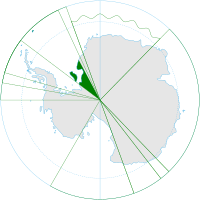
Back المقاطعة البرازيلية بالقارة القطبية الجنوبية Arabic Propuesta de L'Antártida brasilana AST Braziliya Antarktikası Azerbaijani Бразільская Антарктыка Byelorussian Antàrtida brasilera Catalan Propuesta de Antártida brasileña Spanish جنوبگان برزیل Persian Antarctique brésilien French אנטארקטיקה הברזילאית HE Բրազիլական Անտարկտիկա Armenian
Brazilian Antarctica
Antártica Brasileira (Portuguese) | |
|---|---|
 Coordinates: |
Brazilian Antarctica (Portuguese: Antártida Brasileira or Antártica Brasileira) is the Antarctic territory south of 60°S, and from 28°W to 53°W, proposed as "Zone of Interest" by geopolitical scholar Therezinha de Castro.[1][2][3] While the substance of that designation has never been precisely defined, it does not formally contradict the Argentine and British claims geographically overlapping with that zone (the zone shares a border but does not overlap with the Chilean Antarctic Territory to its west). The country formally expressed its reservations with respect to its territorial rights in Antarctica when it acceded to the Antarctic Treaty on 16 May 1975, making the first official mention of the Frontage Theory, which states (simplified) that sovereignty over each point in Antarctica properly belongs to the first country whose non-Antarctic territory one would reach when travelling north in a straight line from such a point.[4][5] The Frontage Theory (Teoria da Defrontação) was proposed by Brazilian geopolitical scholar Therezinha de Castro and published in her book Antártica: Teoria da Defrontação.
Outside the zone of interest, Brazil maintains a permanently staffed research facility, the Comandante Ferraz Brazilian Antarctic Base (UN/LOCODE: AQ-CFZ), located in Admiralty Bay, King George Island, near the tip of the Antarctic Peninsula, at 62°08′S 58°40′W / 62.133°S 58.667°W. The peninsula is the northernmost, most accessible, and warmest part of the Antarctic continent and a number of countries, therefore, have research bases located on it.
- ^ Canadian Polar Commission - Meridian (p. 5) Archived 2017-06-14 at the Wayback Machine Canadian Polar Commission. Retrieved on 2010-10-23.
- ^ It's not just science that's an experiment in Antarctica Exploratorium. Retrieved on 2010-10-23.
- ^ World Statesmen.org: Antarctic Territorial Claims Worldstatesmen.org. Retrieved on 2010-10-23.
- ^ La Antátida (p. 6) Archived 2016-04-10 at the Wayback Machine Asociación de Funcionarios y Empleados del Servicio Exterior Ecuatoriano. Retrieved on 2010-10-23. (in Spanish).
- ^ O Projeto Brasileiro para a Antartica (p. 119) Archived July 21, 2011, at the Wayback Machine Revista Brasileira de Política Internacional. Retrieved on 2010-10-23. (in Portuguese).